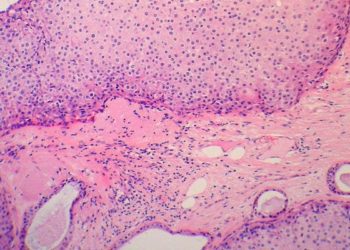Trastuzumab emtansine prolongs disease-free survival in HER2-positive breast cancer
Image: CC
Key findings:
1. Trastuzumab emtansine (T-DM1), an antibody-drug conjugate, prolonged disease-free survival compared to lapatinib plus capecitabine in HER2-positive breast cancer.
2. T-DM1 had less severe toxicity than lapatinib plus capecitabine.
Primer: A monoclonal antibody against human epidermal growth factor receptor 2 (HER2), trastuzumab (Herceptin), prevents progression and increases overall survival in patients with metastatic HER2-positive breast cancer. Patients who fail therapy with trastuzumab, an anthracycline, and a taxane are treated with lapatinib and capecitabine (LC). Trastuzumab-emtansine (T-DM1) is a conjugate of the monoclonal antibody to a cytotoxic microtubule inhibitor. The drug was developed based on the theory the antibody would allow targeted intracellular delivery of the toxin, increasing the therapeutic effect while decreasing adverse effects. Based on promising Phase 2 results, the authors conducted the EMILIA trial, reported in today’s New England Journal of Medicine.
Further reading:
1. Hudis, CA. Trastuzumab — Mechanism of Action and Use in Clinical Practice. N Engl J Med 2007;357:39-51
The [prospective] study: EMILIA was a randomized, open-label trial of 991 patients with nonresectable locally-advanced or metastatic HER2-positive breast cancer who had disease progression after previous treatment with a taxane and trastuzumab. They were randomized to LC (496 patients) or T-DM1 (495 patients), and stratified based on region, number of prior chemotherapy regimens, and visceral vs. non-visceral disease. The primary endpoint was progression-free survival assessed by an independent reviewer, based on modified RECIST criteria.
Median progression-free survival was 9.6 months for the T-DM1 group and 6.4 months for the LC group (hazard ratio for all-cause mortality or progression: 0.65, p <0.001) in an intention to treat analysis. A second interim analysis added to the trial design after the first interim analysis (median follow up 19 months) found a median survival of 30.9 months vs. 25.1 months (hazard ratio, 0.68).
The most common grade 3 or 4 adverse effects were diarrhea (20.7%) and palmar-plantar erythrodysesthesia (16.4%) in the LC arm, and thrombocytopenia (12.9%) and elevated AST (4.3%) in the T-DM1 arm. Adverse events were common in both groups (97.7% and 95.9%, respectively), and “serious” adverse events (not defined) occurred in 18.0% of the LC arm and 15.5% of the T-DM1 arm.
In sum: Trastuzumab-emtansine represents a new category of targeted cancer therapies. This Phase 3 trial provides compelling evidence for the compound as a therapy to improve progression-free survival and overall survival in patients with HER2-positive breast cancer resistant to first-line therapy.
Although there were fewer grade 3 or 4 adverse events (57.0% vs. 40.8%) in the T-DM1 arm, adverse events were common in both arms, and there may be a reporting bias in both the severity and frequency of adverse events in an open-label trial. EMILIA was sponsored by F. Hoffman-La Roche/Genentech. Sponsor representatives were involved in the trial design, and the first draft was written with the assistance of a medical writer paid by the sponsors.
Written by AS
© 2012 2minutemedicine.com. All rights reserved. No works may be reproduced without written consent from 2minutemedicine.com. DISCLAIMER: Posts are not medical advice and are not intended as such. Please see a healthcare professional if you seek medical advice.




